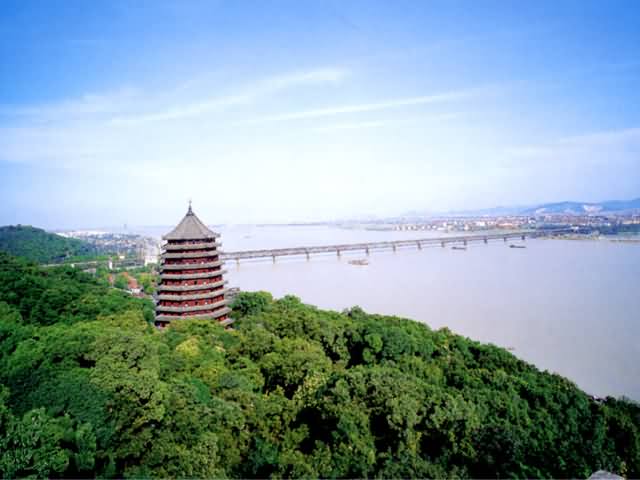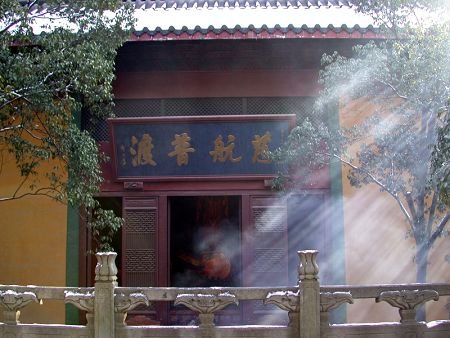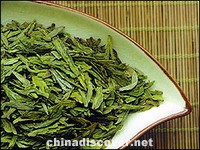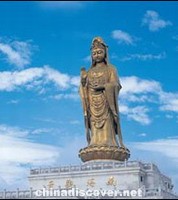Lanxi Village
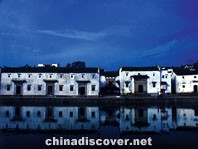
During the Ming (1368-1644) and Qing (1644-1911) dynasties this great statesman's descendants built Zhuge Bagua Village in the mountains of Lanxi, Zhejiang Province, in honor of their revered ancestor. It was, and is, unique for its layout, which resembles the Bagua, or Eight Trigrams formation. As such, it is a living cultural relic, whose original 200 residences and 18 halls, wells and main lanes stand to this day. Dagong Hall, built nearly 600 years ago, is the sole Zhuge Liang Memorial in southern China, and the Prime Minister Memorial, built 400 years ago, is the main Zhuge clan ancestral temple.
Three Wonders
Zhuge Liang (181-234) was prime minister of the Kingdom of Shu during the Three Kingdoms Period (220-280). His legendary prowess as military strategist and thinker are chronicled in the classic Chinese novel The Romance of the Three Kingdoms that, in China, is read by young and old alike.
Zhuge Liang was actually born in Yinan, Shandong Province. It was in the 10th century that his 14th-generation descendant, Zhuge Li, left Shandong to take up a posting in Shouchang County (present-day Jiande City) in Zhejiang Province where he made his home. In 1340, Zhuge Dashi, the 27th-generation Zhuge Liang descendant, and expert geomancer and architect, moved to and settled where Zhuge Bagua Village now stands. It was he that surveyed the site and planned the village's construction.
This village has three remarkable features. First and foremost, the majority of villagers living in Zhuge Bagua Village today constitute a full quarter of Zhuge Liang's remaining 16,000 46th- to 55th-generation descendants, according to statistics released at the China National Seminar on Zhuge Liang in 1993. Of its 5,000 residents in 1,200 households, 80 percent belong to the Zhuge clan.
The second extraordinary aspect of the village is its layout. A bird's-eye view plainly reveals its layout as similar in formation to that of the Eight Trigrams – a circular arrangement of combinations of eight pairs of three whole and 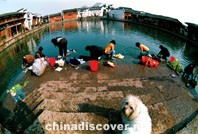 three broken lines that give the 64 hexagrams appearing in the classic I Ching, or Book of Changes. The topography of the village resembles a frying pan: flat at the center, bounded by eight hills in eight compass directions. Eight lanes radiate from a pond at the center of the village to form the inner Bagua, and the eight hills surrounding it form the outer Bagua. To newcomers, the village is a labyrinth, impossible to navigate without the help of a guide. Local residents feel secure in the knowledge that any thieves covertly entering the village would inevitably be captured, simply because they would be unable to find a way out.
three broken lines that give the 64 hexagrams appearing in the classic I Ching, or Book of Changes. The topography of the village resembles a frying pan: flat at the center, bounded by eight hills in eight compass directions. Eight lanes radiate from a pond at the center of the village to form the inner Bagua, and the eight hills surrounding it form the outer Bagua. To newcomers, the village is a labyrinth, impossible to navigate without the help of a guide. Local residents feel secure in the knowledge that any thieves covertly entering the village would inevitably be captured, simply because they would be unable to find a way out.
The third unique aspect of the village is its well-preserved architecture and cultural relics, the earliest of which dates back 700 years. Despite repeated warfare that laid waste to so many ancient pieces of architecture during China's various dynastic changes, not to mention countless natural disasters, Zhuge Bagua Village has survived throughout the centuries since it was built. During the Northern Expedition (1926-1927) troops battled close to the village for three full days, but it escaped shelling. At the time of the War of Resistance Against Japanese Aggression (1937-1945), Japanese troops marched along the road bordering the village, yet failed to discover it. Damage was suffered by one house only, during a Japanese air raid.
In late 1996, Zhuge Bagua Village was designated a national key historical site whose ancient buildings are characterized by their “varied forms, unique structure and good repair.”
“Either Be a Good Prime Minister, Or a Good Doctor”
Two of the most important dates of the year for inhabitants of Zhuge Bagua Village are the anniversary of Zhuge Liang's birth on the14th day of the fourth lunar month, and that of his death on the 28th day of the eighth lunar month. On these days the whole village participates in grand commemoration ceremonies, a temple fair is held and theatrical troupes are invited to perform.
Zhuge Liang was a wise man in addition to being a brilliant strategist. His advice to his descendants was, “If you cannot be a good prime minister, be a good doctor,” in the knowledge that his descendants, as well as others, would benefit from practicing medicine. Zhuge Bagua Village is home to a number of practitioners of traditional Chinese medicine (TCM). Zhuge clan TCM physicians have practices throughout the country, and 200 of them have their own TCM pharmacies.
Among Zhuge Liang's descendants, the Zhuge Chengzai branch that deals in herbal medicines popular throughout the country is the most prosperous. Their achievements are enshrined in the Exhibition Hall of Traditional Chinese Medicine that the Zhuge Chengzai clan built in Zhuge Bagua Village.
There are 17 families living in the village that have worked in traditional Chinese medicine for four generations or more. On the Zhuge Family Tree appears a eulogy to Zhuge ancestors that includes the names of 64 herbal medicines – an indication of the clan's innate literary talent and deep well of erudition in TCM.
